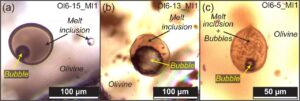Feignon, J.G. ; Cluzel, N. ; Schiavi, F. ; Moune, S. ; Roche, O. ; Clavero, J. ; Schiano, P. ; Auxerre, M.
Bulletin of Volcanology, 2022, 84, 40

Voir en ligne : https://doi.org/10.1007/s00445-022-01550-y
Abstract :
Mocho-Choshuenco volcano has produced several highly explosive eruptions during its history, which make it one of the most hazardous volcanoes in the southern volcanic zone of Chile, although it is still relatively little studied to date. We present a geochemical study of the products of the sub-Plinian, andesitic, Enco eruption that occurred about 1600 years ago. We determined the major and trace elements compositions, as well as the volatile (H2O, CO2, Cl, and S) contents of melt inclusions trapped in minerals (olivine, plagioclase, and pyroxene) using electron microprobe, ion microprobe (SIMS), and 3D confocal Raman mapping. Though the whole-rock composition of the Enco magma is andesitic (60.2 ± 1.1 wt.% SiO2), the melt inclusions have SiO2 contents ranging from 50.3 to 67.3 wt.%, following the magmatic series of Mocho-Choshuenco, and the compositions of the most mafic melt inclusions are close to those of the most mafic erupted magmas. Geochemical modeling indicates that mixing occurred between a mafic magma and an andesitic-to-dacitic magma. Glass analysis revealed typical parental arc magma values for H2O (2.6–3.8 wt.%), S (116–1936 ppm), and Cl (620–1439 ppm). However, CO2 contents are very high in some melt inclusions with concentrations above 4000 ppm (measured in the glass), suggesting trapping depths > 17–22 km. Presence of solid carbonates inside inclusion-hosted bubbles clearly indicates that the CO2 contents measured in the glass phase were minimum values. We conclude that a CO2- rich basaltic magma ascended and mixed with a shallower andesitic magma. The magma cooled and exsolved high amounts of CO2, which may have dramatically increased the pressure and triggered the highly explosive Enco eruption.



